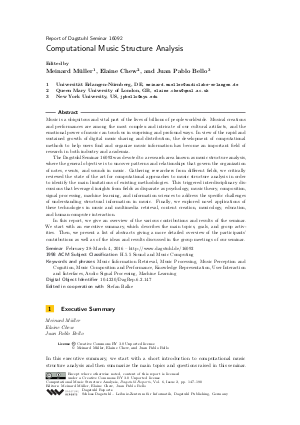Computational Music Structure Analysis (Dagstuhl Seminar 16092)
Authors Meinard Müller, Elaine Chew, Juan Pablo Bello and all authors of the abstracts in this report
-
Part of:
Issue:
Dagstuhl Reports, Volume 6, Issue 2
Part of: Volume: Dagstuhl Reports, Volume 6
Part of: Journal: Dagstuhl Reports (DagRep) - License:
 Creative Commons Attribution 3.0 Unported license
Creative Commons Attribution 3.0 Unported license
- Publication Date: 2016-08-17
File

PDF
DagRep.6.2.147.pdf
- Filesize: 0.95 MB
- 44 pages
Document Identifiers
Subject Classification
Keywords
- Music Information Retrieval
- Music Processing
- Music Perception and Cognition
- Music Composition and Performance
- Knowledge Representation
- User Interaction and Interfaces
- Audio Signal Processing
- Machine Learning
Metrics
- Access Statistics
-
Total Accesses (updated on a weekly basis)
0Document
0Metadata
Abstract
Music is a ubiquitous and vital part of the lives of billions of people worldwide. Musical creations and performances are among the most complex and intricate of our cultural artifacts, and the emotional power of music can touch us in surprising and profound ways. In view of the rapid and sustained growth of digital music sharing and distribution, the development of computational methods to help users find and organize music information has become an important field of research in both industry and academia. The Dagstuhl Seminar 16092 was devoted to a research area known as music structure analysis, where the general objective is to uncover patterns and relationships that govern the organization of notes, events, and sounds in music. Gathering researchers from different fields, we critically reviewed the state of the art for computational approaches to music structure analysis in order to identify the main limitations of existing methodologies. This triggered interdisciplinary discussions that leveraged insights from fields as disparate as psychology, music theory, composition, signal processing, machine learning, and information sciences to address the specific challenges of understanding structural information in music. Finally, we explored novel applications of these technologies in music and multimedia retrieval, content creation, musicology, education, and human-computer interaction. In this report, we give an overview of the various contributions and results of the seminar. We start with an executive summary, which describes the main topics, goals, and group activities. Then, we present a list of abstracts giving a more detailed overview of the participants' contributions as well as of the ideas and results discussed in the group meetings of our seminar.
Cite As Get BibTex
Meinard Müller, Elaine Chew, and Juan Pablo Bello. Computational Music Structure Analysis (Dagstuhl Seminar 16092). In Dagstuhl Reports, Volume 6, Issue 2, pp. 147-190, Schloss Dagstuhl – Leibniz-Zentrum für Informatik (2016)
https://doi.org/10.4230/DagRep.6.2.147
BibTex
@Article{muller_et_al:DagRep.6.2.147,
author = {M\"{u}ller, Meinard and Chew, Elaine and Bello, Juan Pablo},
title = {{Computational Music Structure Analysis (Dagstuhl Seminar 16092)}},
pages = {147--190},
journal = {Dagstuhl Reports},
ISSN = {2192-5283},
year = {2016},
volume = {6},
number = {2},
editor = {M\"{u}ller, Meinard and Chew, Elaine and Bello, Juan Pablo},
publisher = {Schloss Dagstuhl -- Leibniz-Zentrum f{\"u}r Informatik},
address = {Dagstuhl, Germany},
URL = {https://drops.dagstuhl.de/entities/document/10.4230/DagRep.6.2.147},
URN = {urn:nbn:de:0030-drops-61415},
doi = {10.4230/DagRep.6.2.147},
annote = {Keywords: Music Information Retrieval, Music Processing, Music Perception and Cognition, Music Composition and Performance, Knowledge Representation, User Interaction and Interfaces, Audio Signal Processing, Machine Learning}
}
